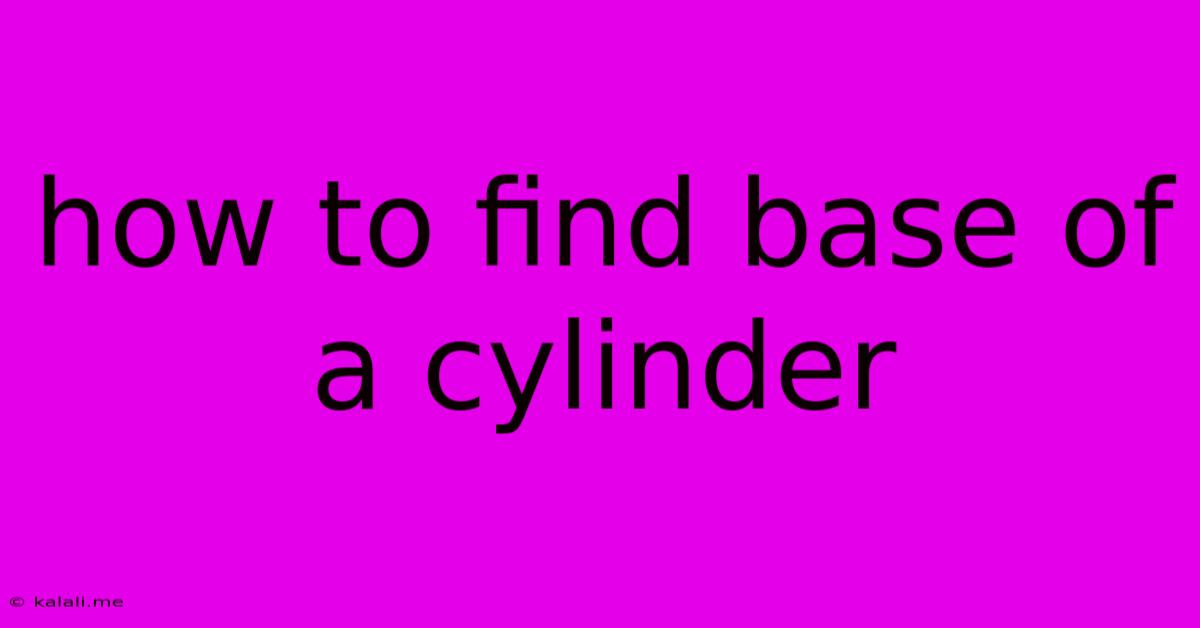How To Find Base Of A Cylinder
Kalali
Jun 15, 2025 · 3 min read

Table of Contents
How to Find the Base of a Cylinder: A Comprehensive Guide
Finding the base of a cylinder might seem straightforward, but understanding the different contexts and approaches is crucial, especially when dealing with more complex problems involving volume, surface area, or geometric relationships. This guide will walk you through various methods to determine the base of a cylinder, covering both its area and its radius/diameter.
Meta Description: Learn how to find the base of a cylinder using different approaches, from simple calculations using the radius or diameter to solving problems involving volume or surface area. This guide clarifies various methods for determining the area and dimensions of a cylinder's base.
Understanding the Cylinder's Base
A cylinder's base is a circle. Therefore, finding the base involves determining either the area of that circular base or the radius (and consequently, the diameter) of that circle. The approach you take depends on the information you're given.
Method 1: Finding the Base Area Given the Radius or Diameter
This is the most straightforward method. If you know either the radius (r) or the diameter (d) of the cylinder's circular base, you can easily calculate its area (A) using the following formulas:
- Area (A) = πr² (where 'r' is the radius)
- Area (A) = π(d/2)² (where 'd' is the diameter)
Remember that π (pi) is approximately 3.14159. Simply substitute the known radius or diameter into the relevant formula to find the area of the base.
Method 2: Finding the Base Area Given the Cylinder's Volume and Height
If you know the cylinder's volume (V) and height (h), you can derive the base area. The formula for the volume of a cylinder is:
- V = πr²h
Rearranging this formula to solve for the base area (πr²):
- A = V/h
This method effectively calculates the area of the base by dividing the total volume by the height.
Method 3: Finding the Base Area Given the Cylinder's Lateral Surface Area and Height
The lateral surface area (LSA) of a cylinder is the area of its curved surface, excluding the two bases. The formula for LSA is:
- LSA = 2πrh
While you can't directly calculate the base area from the LSA alone, if you also know the height (h), you can find the radius (r) using the following steps:
- Rearrange the LSA formula to solve for r: r = LSA / (2πh)
- Substitute the calculated radius into the base area formula: A = πr²
Method 4: Finding the Radius or Diameter Given the Base Area
If you already know the area (A) of the cylinder's base, you can find the radius (r) and diameter (d) using these formulas:
- Radius (r) = √(A/π)
- Diameter (d) = 2√(A/π)
These formulas are simply rearrangements of the base area formula.
Practical Applications and Example Problems
Understanding these methods is crucial for various applications in engineering, architecture, and other fields. Let's look at an example:
Problem: A cylindrical water tank has a volume of 100 cubic meters and a height of 5 meters. What is the area of its base?
Solution: Using Method 2:
- A = V/h = 100 cubic meters / 5 meters = 20 square meters
Therefore, the area of the base of the cylindrical water tank is 20 square meters.
Conclusion
Finding the base of a cylinder involves understanding the relationship between its volume, height, lateral surface area, radius, and diameter. By applying the appropriate formulas and steps outlined in this guide, you can efficiently determine the dimensions and area of a cylinder's base, regardless of the given information. Remember to always double-check your calculations and units to ensure accuracy.
Latest Posts
Latest Posts
-
What Type Of Slope Failure Is Shown In This Figure
Jun 15, 2025
-
Differentiate Between Short Run And Long Run
Jun 15, 2025
-
What Is The Difference Between An Entrepreneur And Entrepreneurship
Jun 15, 2025
-
Which Of The Following Is A Nonrenewable Energy
Jun 15, 2025
-
Is An Alloy A Heterogeneous Mixture
Jun 15, 2025
Related Post
Thank you for visiting our website which covers about How To Find Base Of A Cylinder . We hope the information provided has been useful to you. Feel free to contact us if you have any questions or need further assistance. See you next time and don't miss to bookmark.